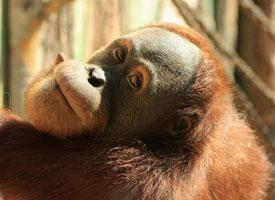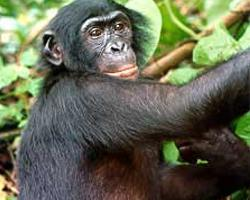
Váhy a míry
| Výška v kohoutku | od 1,1 do 1,5 m |
|---|---|
| Hmotnost | od 30 do 90 kg |
Biologická data
| Délka březosti | od 235 do 265 d |
|---|---|
| Počet mláďat | 1 - 2 |
Popis zvířete
Orangutans, belonging to the genus Pongo, are among the most iconic and fascinating primates on the planet. Native primarily to the lush rainforests of Borneo and Sumatra, these magnificent creatures are the world's largest arboreal mammals, spending most of their lives in trees. Their name, derived from the Malay words "orang" meaning "person" and "hutan" meaning "forest," translates to "person of the forest," a testament to their remarkable human-like qualities.Orangutans have a distinctive appearance that sets them apart from other great apes. They possess a robust body covered in a thick, reddish-brown fur, unlike the darker hair of gorillas and chimpanzees. Adult males are particularly striking, featuring large cheek pads known as flanges, a prominent throat pouch used to amplify their long calls, and can weigh up to 220 pounds (100 kilograms). Females are significantly smaller but share the same expressive face and intelligent gaze.
These primates are renowned for their extraordinary intelligence and have been observed using tools in the wild. They demonstrate remarkable problem-solving skills, such as using leaves as gloves to handle prickly fruit or as umbrellas to shelter from the rain. Orangutans are also known for their intricate nest-building abilities, constructing new sleeping nests out of branches and foliage each night.
Orangutans are primarily solitary animals, with social bonds mostly occurring between mothers and their dependent offspring. The mother-infant bond is especially strong, with young orangutans staying with their mothers for about six to seven years, learning essential survival skills such as foraging and nest building. This extended period of learning is necessary due to the complex social behaviors and diverse diet of over 300 types of fruit and other materials they need to remember.
Despite their adaptability, orangutans face numerous threats that have led to a sharp decline in their population. Deforestation, habitat loss due to palm oil plantations, illegal logging, and poaching are the primary threats to their survival. Both the Bornean and Sumatran species are classified as critically endangered, with the recently identified Tapanuli orangutan also facing imminent extinction.
Conservation efforts are underway to protect and preserve these incredible beings and their habitats. These include anti-poaching patrols, habitat restoration projects, and initiatives aimed at promoting sustainable palm oil production. Rehabilitation centers and sanctuaries also play a crucial role in rescuing and rehabilitating orphaned and displaced orangutans, with the ultimate goal of reintroducing them into the wild.
Orangutans are a symbol of the intricate connections between forests, wildlife, and human activity. Their plight highlights the urgent need for comprehensive and integrated conservation strategies that ensure the survival of these magnificent "people of the forest" and the preservation of their tropical rainforest home for future generations.
Mapa výskytu

Podobná zvířata
Nové fotografie zvířat
Top 10 zvířat
- Dolphin gull (Leucophaeus scoresbii)
- Diana monkey (Cercopithecus diana)
- Moustached guenon (Cercopithecus cephus)
- Galápagos tortoise (Geochelone nigra complex)
- Stone loach (Barbatula barbatula)
- Japanese macaque (Macaca fuscata)
- Greek tortoise (Testudo graeca)
- Russian tortoise (Testudo horsfieldii)
- Common flying dragon (Draco volans)
- Galápagos penguin (Spheniscus mendiculus)


